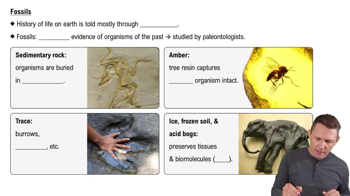Table of contents
- 1. Introduction to Biology2h 42m
- 2. Chemistry3h 37m
- 3. Water1h 26m
- 4. Biomolecules2h 23m
- 5. Cell Components2h 26m
- 6. The Membrane2h 31m
- 7. Energy and Metabolism2h 0m
- 8. Respiration2h 40m
- 9. Photosynthesis2h 49m
- 10. Cell Signaling59m
- 11. Cell Division2h 47m
- 12. Meiosis2h 0m
- 13. Mendelian Genetics4h 44m
- Introduction to Mendel's Experiments7m
- Genotype vs. Phenotype17m
- Punnett Squares13m
- Mendel's Experiments26m
- Mendel's Laws18m
- Monohybrid Crosses19m
- Test Crosses14m
- Dihybrid Crosses20m
- Punnett Square Probability26m
- Incomplete Dominance vs. Codominance20m
- Epistasis7m
- Non-Mendelian Genetics12m
- Pedigrees6m
- Autosomal Inheritance21m
- Sex-Linked Inheritance43m
- X-Inactivation9m
- 14. DNA Synthesis2h 27m
- 15. Gene Expression3h 6m
- 16. Regulation of Expression3h 31m
- Introduction to Regulation of Gene Expression13m
- Prokaryotic Gene Regulation via Operons27m
- The Lac Operon21m
- Glucose's Impact on Lac Operon25m
- The Trp Operon20m
- Review of the Lac Operon & Trp Operon11m
- Introduction to Eukaryotic Gene Regulation9m
- Eukaryotic Chromatin Modifications16m
- Eukaryotic Transcriptional Control22m
- Eukaryotic Post-Transcriptional Regulation28m
- Eukaryotic Post-Translational Regulation13m
- 17. Viruses37m
- 18. Biotechnology2h 58m
- 19. Genomics17m
- 20. Development1h 5m
- 21. Evolution3h 1m
- 22. Evolution of Populations3h 53m
- 23. Speciation1h 37m
- 24. History of Life on Earth2h 6m
- 25. Phylogeny2h 31m
- 26. Prokaryotes4h 59m
- 27. Protists1h 12m
- 28. Plants1h 22m
- 29. Fungi36m
- 30. Overview of Animals34m
- 31. Invertebrates1h 2m
- 32. Vertebrates50m
- 33. Plant Anatomy1h 3m
- 34. Vascular Plant Transport1h 2m
- 35. Soil37m
- 36. Plant Reproduction47m
- 37. Plant Sensation and Response1h 9m
- 38. Animal Form and Function1h 19m
- 39. Digestive System1h 10m
- 40. Circulatory System1h 49m
- 41. Immune System1h 12m
- 42. Osmoregulation and Excretion50m
- 43. Endocrine System1h 4m
- 44. Animal Reproduction1h 2m
- 45. Nervous System1h 55m
- 46. Sensory Systems46m
- 47. Muscle Systems23m
- 48. Ecology3h 11m
- Introduction to Ecology20m
- Biogeography14m
- Earth's Climate Patterns50m
- Introduction to Terrestrial Biomes10m
- Terrestrial Biomes: Near Equator13m
- Terrestrial Biomes: Temperate Regions10m
- Terrestrial Biomes: Northern Regions15m
- Introduction to Aquatic Biomes27m
- Freshwater Aquatic Biomes14m
- Marine Aquatic Biomes13m
- 49. Animal Behavior28m
- 50. Population Ecology3h 41m
- Introduction to Population Ecology28m
- Population Sampling Methods23m
- Life History12m
- Population Demography17m
- Factors Limiting Population Growth14m
- Introduction to Population Growth Models22m
- Linear Population Growth6m
- Exponential Population Growth29m
- Logistic Population Growth32m
- r/K Selection10m
- The Human Population22m
- 51. Community Ecology2h 46m
- Introduction to Community Ecology2m
- Introduction to Community Interactions9m
- Community Interactions: Competition (-/-)38m
- Community Interactions: Exploitation (+/-)23m
- Community Interactions: Mutualism (+/+) & Commensalism (+/0)9m
- Community Structure35m
- Community Dynamics26m
- Geographic Impact on Communities21m
- 52. Ecosystems2h 36m
- 53. Conservation Biology24m
24. History of Life on Earth
History of Life on Earth
Problem 1
Textbook Question
Fossilized stromatolites:
a. Formed around deep-sea vents.
b. Resemble structures formed by bacterial communities that are found today in some shallow marine bays.
c. Provide evidence that plants moved onto land in the company of fungi around 500 million years ago.
d. Contain the first undisputed fossils of eukaryotes.
 Verified step by step guidance
Verified step by step guidance1
Understand what stromatolites are: Stromatolites are layered structures formed by the growth of microbial mats, primarily cyanobacteria. They are among the oldest evidence of life on Earth.
Consider the environments where stromatolites are typically found: Stromatolites are often found in shallow marine environments where sunlight can penetrate, allowing photosynthetic bacteria to thrive.
Evaluate the options given in the problem: a) deep-sea vents, b) shallow marine bays, c) evidence of plants and fungi moving onto land, d) first fossils of eukaryotes.
Analyze each option: a) Stromatolites are not typically associated with deep-sea vents, which are environments for chemosynthetic organisms. b) Stromatolites resemble structures formed by bacterial communities in shallow marine bays today. c) Stromatolites do not provide evidence of plants and fungi moving onto land. d) Stromatolites do not contain eukaryotic fossils; they are primarily associated with prokaryotic life.
Conclude which option best describes fossilized stromatolites: Based on the analysis, option b is the most accurate description, as stromatolites resemble structures formed by bacterial communities found in shallow marine bays today.
 Verified video answer for a similar problem:
Verified video answer for a similar problem:This video solution was recommended by our tutors as helpful for the problem above
Video duration:
2mPlay a video:
Was this helpful?
Key Concepts
Here are the essential concepts you must grasp in order to answer the question correctly.
Stromatolites
Stromatolites are layered sedimentary formations created by the growth of microbial mats, primarily cyanobacteria. These structures are among the oldest evidence of life on Earth, dating back over 3.5 billion years. Modern stromatolites can still be found in some shallow marine environments, resembling ancient formations and providing insights into early life and its environmental interactions.
Recommended video:
Guided course

Prokaryote Lineages 2
Bacterial Communities
Bacterial communities, such as those forming stromatolites, consist of diverse microorganisms that interact with each other and their environment. These communities can create complex structures through processes like photosynthesis and sediment trapping. Understanding these communities helps explain how early life forms could alter their surroundings and contribute to the formation of geological features.
Recommended video:
Guided course

Community Structure
Fossil Evidence of Early Life
Fossils provide crucial evidence of early life forms and their evolution. Stromatolites, as fossilized microbial mats, offer insights into the conditions and types of life that existed billions of years ago. They are not related to the movement of plants onto land or the first eukaryotes, but they are significant for understanding the early biosphere and the role of microorganisms in Earth's history.
Recommended video:

Fossils
Related Videos
Related Practice
Multiple Choice
In the species selection model, __________ is to macroevolution as __________ is to microevolution.
1307
views


